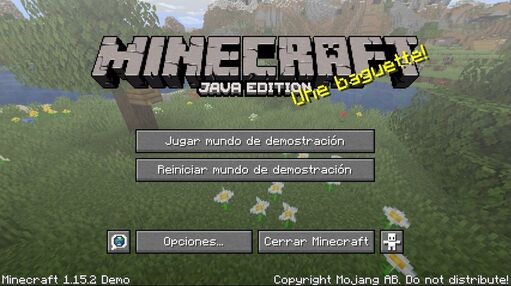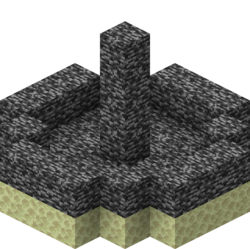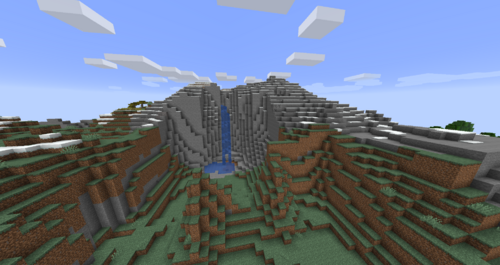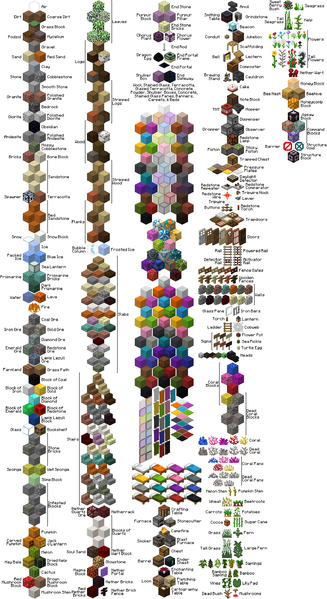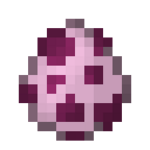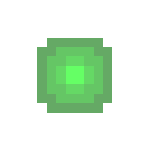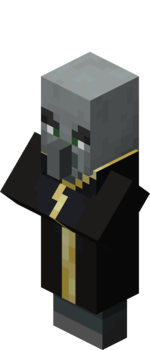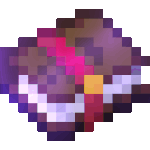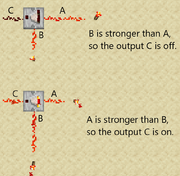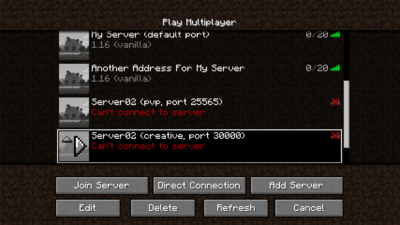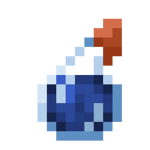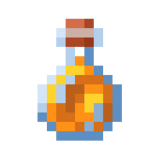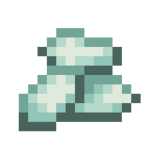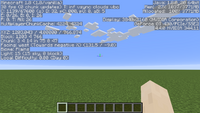This article is about mechanical of enchantment.
Summary
- 1 Basic mechanics
- 2 Placement of shelves
- 3 How enchantments are chosen
- 3.1 Step One - Apply Modifiers to Enchantment Level
- 3.1.1 Enchanting
- 3.1.2 Pseudocode from step 1
- 3.2 Step Two - Finding Possible Enchantments
- 3.2.1 Treasury
- 3.3 Step 3 - Select a set of enchantments from the list
- 3.4 Incompatible enchantments
- 3.1 Step One - Apply Modifiers to Enchantment Level
- 4 Curiosities
- 5
- 6 External links
Basic mechanics
Whenever the player places an eligible item on the enchantment table, the available enchantment levels are randomly generated for each space using the following formula. The enchantment level depends on the number of nearby libraries (with a limit of 15) and the position in which it is located.
Base enchantment level available (base) = (1..8 & nbsp; + floor (b / 2) & nbsp; + 0 .. b),
where b is the number of nearby libraries (maximum of 15) and x .. and generates a random integer uniformly distributed between x and y, inclusive. This is then modified according to the position of the slot:
Enchantment level of upper slot = floor (max (base / 3, 1)) Enchantment level of middle slot = floor ((base & times; 2) / 3 + 1) Enchantment level of lower slot = floor (max (base, b and times; 2))where max (x, y) returns the larger of two x and y values.
| # of libraries | 0 | 1 | 2 | 3 | 4 | 5 | 6 | 7 | 8 | 9 | 10 | 11 | 12 | 13 | 14 | 15 |
|---|---|---|---|---|---|---|---|---|---|---|---|---|---|---|---|---|
| Minimum level (in the upper slot) | 1 | 1 | 1 | 1 | 1 | 1 | 1 | 1 | 1 | 1 | 2 | 2 | 2 | 2 | 2 | 2 |
| Maximum level (in the lower slot) | 8 | 9 | 11 | 12 | 14 | 15 | 17 | 18 | 20 | 21 | 23 | 24 | 26 | 27 | 29 | 30 |
| # of libraries | 0 | 1 | 2 | 3 | 4 | 5 | 6 | 7 | 8 | 9 | 10 | 11 | 12 | 13 | 14 | 15 |
|---|---|---|---|---|---|---|---|---|---|---|---|---|---|---|---|---|
| Top slot rank level | 1-2 | 1-3 | 1-3 | 1-4 | 1-4 | 1-5 | 1-5 | 1-6 | 1-6 | 1-7 | 2-7 | 2-8 | 2-8 | 2-9 | 2-9 | 2-10 |
| Rank level in the middle slot | 1-6 | 1-7 | 2-8 | 2-9 | 3-10 | 3-11 | 3-12 | 3-13 | 4-14 | 4-15 | 5-16 | 5-17 | 5-18 | 5-19 | 6-20 | 6-21 |
| Rank level in the lower slot | 1-8 | 2-9 | 4-11 | 6-12 | 8-14 | 10-15 | 12-17 | 14-18 | 16-20 | 18-21 | 20-23 | 22-24 | 24-26 | 26-27 | 28-29 | 30 |
Note: Keep in mind that a higher experience cost for a specific space does not necessarily mean that the enchantments in that space are better than the lower cost ones.
In Creative mode, experience levels are not required for enchantments.
Shelving placement
Near a bookstore the available enchantment levels increase; without libraries, the experience level requirement never exceeds 8.
To have an effect, a bookcase must be placed exactly 2 blocks, laterally, outside the lovely table and be on the same level or one block high above the table, and the 2-height space between the shelf and the table must be air (even a torch, a layer of snow, or a carpet blocks the effect), where "between" is as shown in the following diagrams (the blanks are air, and the doesn't matter):
| From above: |
|
o |
| ||||||||||||||||||
|---|---|---|---|---|---|---|---|---|---|---|---|---|---|---|---|---|---|---|---|---|---|
| And on the side: |
|
o |
|
Glyph particles, which fly from the shelves, follow different rules and can appear even if the shelves don't enhance the table.
There are many possible fixes from the libraries that can reach the enchantment limit. A simple method is to surround the lovely table with a 1-block-high square of shelving with an empty space anywhere on the perimeter:
Another alternative that is now available is to build a 'library corner' where each shelf is two blocks high, as in the plan below. This arrangement gives space for 16 bookcases, which is one more than is necessary, so if the column of the corner shelf is not visible, removing one of the two shelves has no effect, technical or visual.
Select an enchantment level
Since the enchantments offered depend on the enchantment level and the enchantment level depends on the number of active libraries, an easy way to change the enchantments offered is to deactivate the shelves by placing torches between them and the enchantment table. That way, one can have the entire 'ring' of shelving around the table, but still get lower-tier enchantments. Breaking the torches restores the effect of the bookshelves.
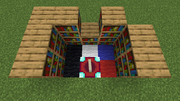
A table of enchantments with bookstores around it.
With the layout shown here, enchantments can be easily obtained with any number of libraries from 0 to 15:
| Active Libraries | ||||
|---|---|---|---|---|
| 0 | ||||
| 1 | ||||
| 2 | ||||
| 3 | ||||
| 4 | ||||
| 5 | ||||
| 6 | ||||
| 7 | ||||
| 8 | ||||
| 9 | ||||
| 10 | ||||
| 11 | ||||
| 12 | ||||
| 13 | ||||
| 14 | ||||
| 15 |
How enchantments are chosen
"Enchantment Level" is the required experience level (the green number in the lower right). "Power of enchantment" is the strength of the particular enchantment. For example, "Sharpness IV" has a power of 4. The enchantment algorithm uses a three-step process.
Step One - Apply Modifiers to Enchantment Level
The first thing Minecraft does is apply two modifiers to the base enchantment level. Each modifier is restricted to a certain range, with numbers near the middle of the range more common than those near the extremes.
The first modifier is based on the item's "enchantment ability", which depends on the material and type of item (see table below). Other enchanting items such as books, bows, crossbows, tridents, and fishing rods have an enchantment capacity of 1 for this purpose. Minecraft chooses a number between 0 and half the enchantment, then adds that number plus one to the enchantment level. This random value follows a triangular distribution (like rolling a pair of dice and adding), so results close to a quarter of the enchantment are much more likely than results at the extremes.
The modified enchantment level is calculated with the following formula:
Modified enchantment level = B + R1 + R2 + 1Where:
- R1 and R2 are two randomly generated individual integers:
- B is the base of the enchantment.
- E is the enchantment of the item.
The division is rounded down.
Enchantment
| Material | Armor enchantment | Weapon / Tool Enchantment |
|---|---|---|
| Madera | N/A | 15 |
| Leather | 15 | N/A |
| Stone | N/A | 5 |
| Cota | 12 | N/A |
| Iron | 9 | 14 |
| Gold | 25 | 22 |
| Diamond | 10 | 10 |
| Turtle helmet | 9 | N/A |
| Netherite | 15 | 15 |
| Other | 1 | 1 |
Next, "Minecraft" chooses a value between 0,85 and 1,15, again with a triangular distribution. The modified enchantment level is multiplied by this value (so it could be increased or decreased by up to 15%) and then rounded to the nearest whole number.
Pseudocode from step 1
// Returns a random integer uniformly distributed between 0 and n - 1, including function randomInt (n); // Returns a random (fractional) real number evenly distributed between 0 (inclusive) and 1 (exclusive) function randomFloat (); // Returns the real number n rounded to the nearest integer. round function (n); // Generate a random number between 1 and 1+ (enchantment / 2), with a triangular distribution int rand_enchantability = 1 + randomInt (enchantment / 4 + 1) + randomInt (enchantment / 4 + 1); // Choose enchantment level int k = chosen_enchant_level + enchantment_rand; // A random bonus, between .85 and 1.15 float rand_bonus_percent = 1 + (randomFloat () + randomFloat () - 1) * 0.15; // Finally, we calculate the level int final_level = round (k * rand_bonus_percent); if (final_level <1) final_level = 1
Resource taken from the code of "Minecraft" 1.8
Step Two - Find Possible Enchantments
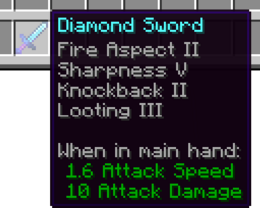
A sword with some enchantments.
Now, based on the modified level, "Minecraft" lists all the types of enchantments that can be applied to the target item along with the power that each enchantment has.
The power of each type of enchantment is determined by the level and the values in the enchantment level table. For each power value of an enchantment type, there is a modified minimum and maximum level that the enchantment can produce at that power. If the modified enchantment level is within range, then the enchantment is assigned that power. If the modified level is within two overlapping ranges for the same enchantment type, the higher power value is used.
Tesoro
Some enchantments are "treasure enchantments" (shown in the table below), which means that they can never be created by an enchantment table and can only be discovered in certain situations: when generating chest loot (equipment and books) , when fishing, when an enchanted book spawns exchanges, when bartering, and when an enchanted book is thrown by an illager assault. [Bedrock Edition only]
Step 3 - Select a set of enchantments from the list
Now that you have a list of possible enchantments for the item, Minecraft needs to choose a few of them to apply. Each enchantment has a statistical "weight". Enchantments with higher weight have a higher chance of being selected.
In detail, Minecraft uses the following weighted random selection algorithm:
- Find the total weight of all the enchantments on the list (T). The total for each enchantment is 136.
- Pick a random integer in the middle of the range [0; T) as a number w.
- Repeat each incantation on the list, subtracting its weight from w. If w is now negative, select the current enchantment.
This algorithm produces the same results as listing each enchantment the number of times given by its weight, then choosing a random entry from the combined list.
So, for each enchantment on the list, the probability of it being selected is:
P = Insole: SfracWhere:
- w is the weight of the enchantment.
- T is the total weight of all the enchantments on the list.
| Enchantment type | Enchantment | Weight | Obtainable from the enchantment table |
|---|---|---|---|
| Armor | Protection | 10 | Si |
| Feather drop | 5 | Si | |
| Protection against the fire | 5 | Si | |
| Protection against projectiles | 5 | Si | |
| Aquatic affinity | 2 | Si | |
| Protection against explodes | 2 | Si | |
| Breathing | 2 | Si | |
| Deep walker | 2 | Si | |
| Ice Cream Step | 2 | No | |
| Thorns | 1 | Si | |
| Curse of ligature | 1 | No | |
| Soul speed | 1 | No | |
| Sword | Wire | 10 | Si |
| Curse of the Arthropods | 5 | Si | |
| Recoil | 5 | Si | |
| Punishment | 5 | Si | |
| I look up to the fiery | 2 | Si | |
| Pillage | 2 | Si | |
| Swept | 2 | Si | |
| Pico Pala Ax Azada Scissors |
Efficiency | 10 | Si |
| Fortuna | 2 | Si | |
| Silk touch | 1 | Si | |
| bow | Power | 10 | Si |
| Flama | 2 | Si | |
| Punch | 2 | Si | |
| Infinity | 1 | Si | |
| Rod | Lucky Marina | 2 | Si |
| Fish hook | 2 | Si | |
| Trident | Loyalty | 5 | Si |
| Impalement | 2 | Si | |
| Countercurrent | 2 | Si | |
| Canalization | 1 | Si | |
| Crossbow | Fast charge | 5 | Si |
| Multi shot | 2 | Si | |
| Drilling | 10 | Si | |
| For all | Unbreakable | 5 | Yes |
| Repair | 2 | No | |
| Curse of disappearance | 1 | No |
Shields can receive the Unbreakable, Mend, Curse of Disappearance, and Curse of Binding enchantments through the use of Enchanted Books. The player always gets at least one enchantment on an item and there is a chance to receive more. This algorithm chooses additional enchantments:
- With probability (modified level +1) / 50, continue. Otherwise, stop choosing additional enchantments.
- Remove from the list of possible enchantments anything that conflicts with the previously chosen enchantments.
- Choose an enchantment from the possible remaining enchantments (based on weights, as before) and apply it to the item.
- Divide the modified level in half, rounding down (this does not affect the possible enchantments themselves, as they were all previously calculated in Step Two).
- Repeat from the beginning.
When enchanting books using an enchantment table, if multiple enchantments were generated, a randomly selected one is removed from the final list. This does not apply to other enchanted book sources that use enchantment mechanics, such as fishing or chests in spawned structures.
Incompatible enchantments
Some enchantments conflict with other enchantments and therefore both cannot be enchanted on the same item, eliminating the possibility of one gaining a mastered weapon.
The rules for enchantment conflicts are:
- Each enchantment conflicts with itself. (The player cannot obtain a tool with two copies of the Efficiency enchantment.)
- All damage enchantments (Blade, Strike, and Arthropod Bane) conflict with each other.
- All protection enchantments (Protection, Explosion Protection, Fire Protection, Projectile Protection) conflict with each other.
- Touch of Silk and Fortune conflict with each other.
- Frostwalker and Frostwalker conflict with each other.
- Reparation and Infinity conflict with each other.
- Loyalty and Countercurrent conflict with each other.
- Channeling and Countercurrent conflict with each other.
- Multi Shot and Piercing conflict with each other.
Conflicting enchantments can appear on an item with specially crafted / give commands. The behavior of such elements should not be trusted, but in general:
- An item with multiple copies of the same enchantment uses the level of the first copy of that enchantment on the list.
- For armors with conflicting protection enchantments, all enchantments take effect individually.
- For weapons with conflicting damage enchantments, all enchantments take effect individually.
- For tools with Touch of Silk and Fortune, Touch of Silk takes priority over Fortune on blocks affected by both enchantments. Fortune still applies to blocks like crops that are not affected by Silk Touch.
- For Bows with Repair and Infinity, both enchantments work individually.
- For tridents with Loyalty and Riptide, Riptide still functions normally, but the player can no longer cast the trident. However, pitchforks can still be thrown using dispensers.
- For crossbows with Multishot and Piercing, both enchantments work individually.
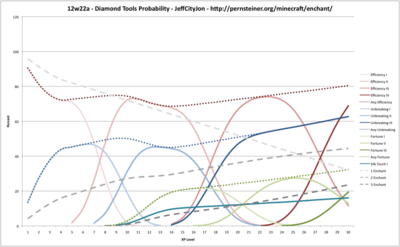
A table showing all the possible enchantments on diamond tools.
Curiosities
- Despite being made primarily of wooden sticks, bows and fishing rods do not have the enchantment ability of wood, and the crossbow does not use the enchantment ability of wood or iron.
Outlinks
- There was a website for testing charms. While it no longer exists, it is still available on the WayBack Machine
- This site provides some ability to test enchantments, although its interface is significantly less detailed.
| Minecraft tutorials | |
|---|---|
| Beginnings of the game |
|
| General |
|
| Mining |
|
| Farms |
|
| Mechanisms |
|
| Technical Assistant |
|
| Outdated |
|
Alejandro Crespo Martinez We are a specialized and passionate team of virtual reality. We have extensive experience in this area. We decided to create ForVirtualRealityLovers to share all our information with customers and users. We have quality information. You can find tips, guides, interviews, top products and much more! If you are curious, enter our site ForVirtualRealityLovers.com and discover the virtual world! ? End City ❯
Articles related to
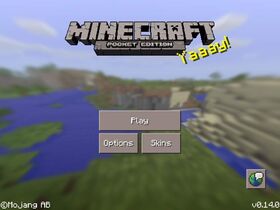
Pocket Edition v0.14.0 alpha

Coral
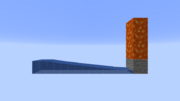
Stone
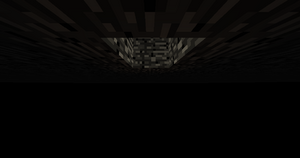
Emptiness





